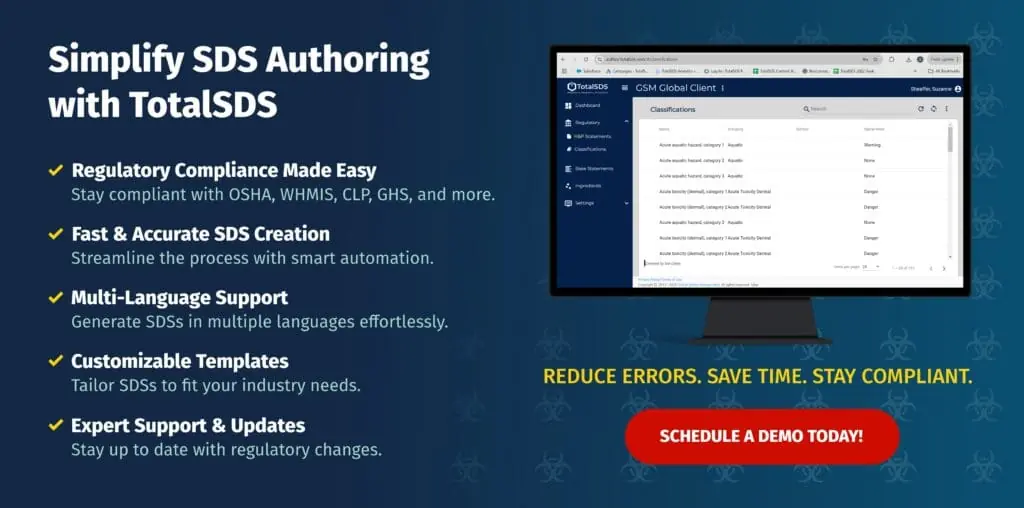Safety Data Sheets (SDS) play a critical role in supply chain management, especially for companies dealing with hazardous chemicals or materials. Here’s how they work within the supply chain and why supply chain safety is of utmost importance. Any U.S. company that purchases, sells or uses chemical-based products must produce mandatory SDS documents and labels that comply with safety regulations (OSHA, DOT, EPA). And as regulatory requirements change, competition increases and pressure for more product stewardship increases, efficiencies and the accuracy of supply chain compliance has become more important than ever before.
Is SDS Mandatory for Every Shipment?
One small formulation, regulatory or supplier change requires new SDS documents to be updated, and constantly changing global regulations can trigger hours of research and translation to make a chemical ingredient update.
When you are manufacturing and distributing products in a global, multi-regulatory environment, what considerations should you keep in mind when creating your safety data sheets to ensure your supply chain runs as smoothly as possible?
What is the Purpose of an SDS?
The purpose of a Safety Data Sheet (SDS) is multifaceted, primarily focusing on the safety, health, and regulatory aspects of handling hazardous chemicals. Here are the main purposes of an SDS:
- Information Provision: SDS provides detailed information about the properties, hazards, handling, storage, and emergency measures related to chemicals or hazardous materials.
- Regulatory Compliance: They ensure that all parties in the supply chain comply with local, national, and international regulations regarding the handling and transport of hazardous substances.
- Safety and Health Protection: They help protect workers, consumers, and the environment by providing essential safety information.
Safety Data Sheet Role in the Supply Chain
- Manufacturers: The creation of the SDS starts with the manufacturer or importer of the chemical product. They are responsible for assessing the hazards and preparing the SDS.
- Distributors: Distributors must ensure that the SDS accompanies the product as it moves through the supply chain. They may also be responsible for providing the SDS to downstream users.
- End-Users: Companies using these chemicals (end-users) rely on SDS to inform their safety practices, training programs, and emergency response procedures. They must ensure that SDS are accessible to employees and that proper training is provided.
How Safety Data Sheets Can Impact Shipping Costs
Depending on the chemical classifications in your product and how and where they are being shipped, over classifying can lead to significant changes in shipping costs. But if overclassifying is more costly, why does it often happen? It’s because the industry approaches the creation of SDSs from the bottom ingredients up, instead of from the hazards down.
Ingredients that are hazardous may lose their hazardous properties when they’re mixed together. While ingredients matter, more than 90% of the information on SDSs is based on the physical properties of the final product, not the ingredients.
As such, having an authoring system or process that groups products in families based on unique hazard combinations and physical states can make all the difference when you’re shipping based on hazardous levels and passing certain thresholds.
Opening in New Markets: Safety Data Sheets and Labels
When you’re trying to stay ahead of the competition and quickly open in new markets, new safety data sheets and labels need to be created that are not only compliant across the new jurisdictions, but also translated into the relevant languages. It’s critical to first understand the regulatory body that is responsible and what their requirements are in order to then create safety data sheets that won’t result in hefty compliance fees or get held up in customs or at the border.
Something as seemingly benign as listing the wrong Chemical Abstract Services (CAS) number in Section 3 of the SDS can lead downstream users (DU) importing that substance to the European Union, for example, to register the wrong substance, purchase the wrong Letter of Access, disrupting their supply chain and delaying their ability to place product on the market.
Once this error is traced back to the SDS, the DU organization will seek damages for the inaccurate CAS number listed on the supplier’s SDS.
Having a safety data sheet authoring system in place that can automate SDS creation based on the jurisdictions and languages required is crucial to a fast, smooth go-to-market strategy.
Automating SDSs with SDS Software Creation
In today’s chemical industry supply chain, manufacturers look for value-added opportunities and improved economies of scale to ensure they aren’t missing out on revenue opportunities. While an ERP system helps manage and automate so many aspects of your business and supply chain, it usually doesn’t include compliance and safety data sheets.
And when you have chemists, supply chain specialists and research and development groups working together, you need a system that can automate safety data sheet authoring and allow you to author and update in a matter of minutes – instead of days or weeks, all while reducing the potential for human error, shipping delays and fines.
At TotalSDS, our SDS authoring software, TotalSDS™ Author, helps ensure product compliance and allows you to scale and enter new markets. With a user-friendly interface and wizard logic, TotalSDS enables you to create and distribute accurate, compliant safety documents in just minutes.
Contact us for a demo with one of our compliance experts today.




